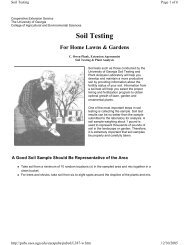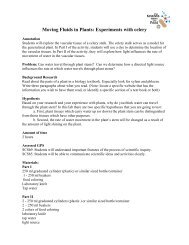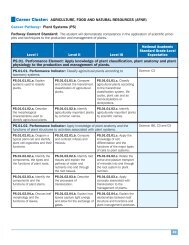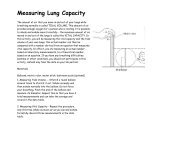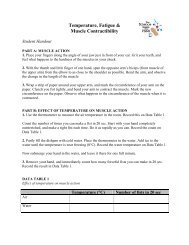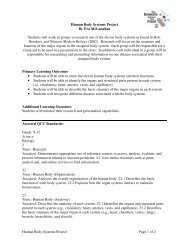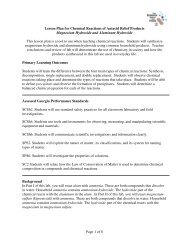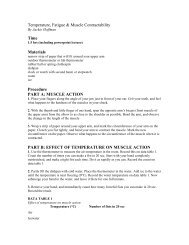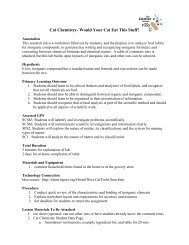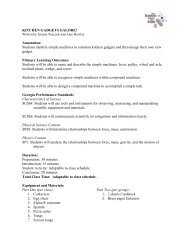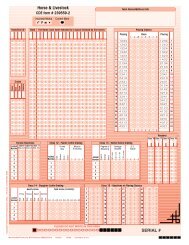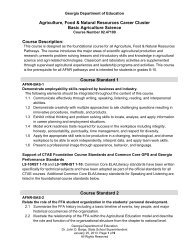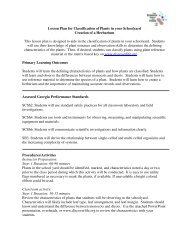Calculating the Half-Life of Twizzlers and M&Mium This lesson plan ...
Calculating the Half-Life of Twizzlers and M&Mium This lesson plan ...
Calculating the Half-Life of Twizzlers and M&Mium This lesson plan ...
- No tags were found...
You also want an ePaper? Increase the reach of your titles
YUMPU automatically turns print PDFs into web optimized ePapers that Google loves.
<strong>Half</strong>-life: Determining <strong>and</strong> Graphing <strong>the</strong> <strong>Half</strong>-life <strong>of</strong> a TwizzlerBackground: You should know <strong>the</strong> term “half-life” <strong>and</strong> know how it is related to radioactiveelements. The half-life <strong>of</strong> a radioactive element is <strong>the</strong> time it takes for half <strong>of</strong> its atoms to decay intosomething else. For example, iodine-125 (I-125) has a half-life <strong>of</strong> about 60 days; <strong>the</strong>refore, in 60 days,1g <strong>of</strong> I-125 will turn into half a gram <strong>of</strong> iodine-125 <strong>and</strong> half a gram <strong>of</strong> something else (<strong>the</strong> radioactivedecay products <strong>of</strong> radium). After ano<strong>the</strong>r 60 days have elapsed, only a ¼ <strong>of</strong> <strong>the</strong> original 1g <strong>of</strong> I-125will remain.Purpose: To determine <strong>the</strong> half-life <strong>of</strong> a Twizzler <strong>and</strong> graph <strong>the</strong> results.Materials:2 <strong>Twizzlers</strong> (1 for Part I <strong>and</strong> 1 for Part II)pencil/pen2 sheets <strong>of</strong> graph paperProcedure: Part I: Amount <strong>of</strong> Twizzler vs. Bites1. Hold original Twizzler vertically against <strong>the</strong> 'y' axis with one end at <strong>the</strong> origin. Mark <strong>the</strong>"length". <strong>This</strong> represents <strong>the</strong> beginning amount.2. Wait for fur<strong>the</strong>r instructions to “Take a ½ bite!” You must eat HALF (<strong>and</strong> only half) <strong>the</strong> length<strong>of</strong> <strong>the</strong> Twizzler.3. Repeat step 1, holding <strong>the</strong> Twizzler a unit from <strong>the</strong> origin. Mark <strong>the</strong> new length (this is your ycoordinate).4. Repeat steps 2 <strong>and</strong> 3 with <strong>the</strong> class until <strong>the</strong> instructor tells you to stop.5. Draw a smooth “Best-Fit” line on your graph.Procedure: Part II: Amount <strong>of</strong> Twizzler vs. Time1. <strong>This</strong> time <strong>the</strong> procedure in Part I will be repeated except <strong>the</strong> instructor will tell you to take abite every 45 seconds <strong>and</strong> record your data!Conclusions <strong>and</strong> Analysis:1. Did <strong>the</strong> Twizzler ever completely disappear? Explain.2. What was <strong>the</strong> half-life <strong>of</strong> <strong>the</strong> Twizzler in Part II?3. If you had started with a GIANT Twizzler (2X <strong>the</strong> normal size) how would this have affected<strong>the</strong> shape <strong>of</strong> <strong>the</strong> graph? Explain.Describe <strong>the</strong> effect on <strong>the</strong> graph if you took a bite every 90 seconds.



